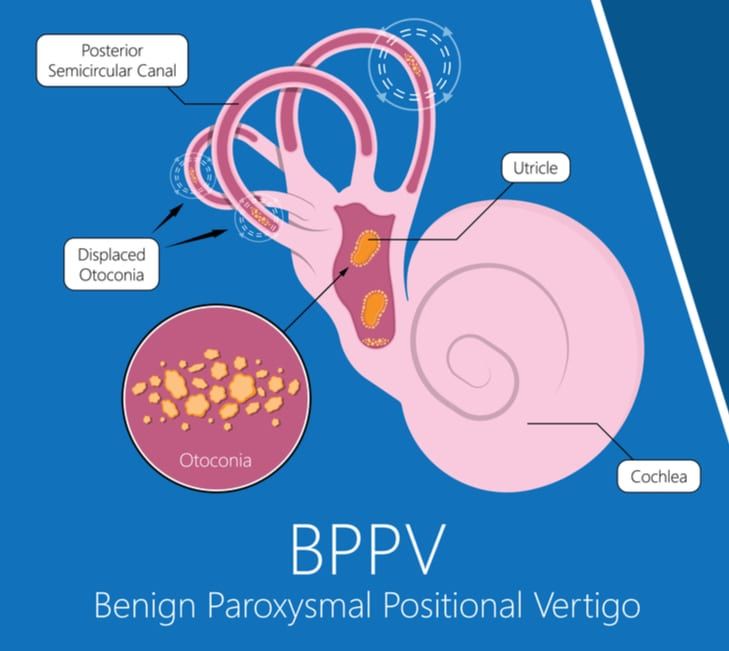Background:
Benign Paroxysmal Positional Vertigo, also known as BPPV is an inner ear disorder. It is one of the most common causes of vertigo which is a sudden sensation of room spinning around you or that the inside of your head is spinning. BPPV causes brief episodes of intense dizziness, typically triggered with head movement in a certain way, rolling over in bed, turning your head quickly, bending over, or tipping your head back.
Causes:
Within the inner ear, collections of calcium crystals known as otoliths lie inside. Those crystals inside our ear monitor different movements of our head in all directions related to gravity. In patients with BPPV, the crystals are dislodged from their usual position, and migrate over time to a different location in the ear into the semicircular canals that contain fluid and fine, hair-like sensors that monitor the rotation of our head especially with a laying down position. This causes the semicircular canal to become very sensitive to head position changes causing you to have repeated episodes of dizziness or spinning sensations.
Signs and Symptoms:
People with BPPV do not usually feel dizzy constantly. Severe dizziness episodes occur as attacks triggered by the slightest head movements. At rest between episodes, patients typically have few or no symptoms. The onset of severe dizziness is typically sudden. Many patients wake up with the condition, noticing the vertigo while trying to sit up suddenly. The main symptom is a feeling that you are spinning around or tilting when you are not. In many cases, the symptoms periodically resolve and then return. The signs and symptoms of BPPV vary among patients, but most episodes are short in duration, with symptoms commonly lasting around 30-seconds. In severe cases, the slightest head movement may also be associated with nausea and vomiting.
Diagnosis:
The diagnosis of a BPPV is based on signs and symptoms. Your clinical history provides a valuable information. Neuroimaging may be necessary to rule out other medical causes of your dizziness. The neurologist will examine you and perform different maneuvers of head movements in the clinic as part of the physical examination to check for vertigo or involuntary eye movements called nystagmus.
Canalith Repositioning Maneuver (Vertigo Treatment):
This maneuver is called the Epley maneuver and will be performed in our office. The canalith repositioning procedure consists of several simple and slow maneuvers for positioning your head. The goal is to rearrange the displaced crystals and move them from the fluid-filled semicircular canals of your inner ear back into the otolith organs in your ear where these particles don’t cause symptoms of vertigo. This therapy has a very high success rate for patients with BPPV.
Each position is held for about 30-seconds after any symptoms or abnormal eye movements stop. This procedure is usually effective and may be repeated if necessary.
Other options are also available but only few medications can be used. These medications usually does not stop the vertigo but it may provide minimal relief for some patients.
Test Preparation:
There is no specific test preparation. The study is very short in duration. The patient generally will be ready to go home immediately following the test. Your neurologist will teach you how to perform the canalith repositioning procedure so that you can do it at home when necessary.
Resources
Vestibular Disorders Association (VEDA)
www.vestibular.org
Citation
Li, John C. “Benign Paroxysmal Positional Vertigo”: Background, Pathophysiology, Epidemiology, Medscape.
URL: emedicine.medscape.com/article/884261
Updated June 29, 2015. Accessed October 13, 2015.




